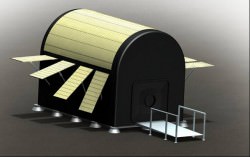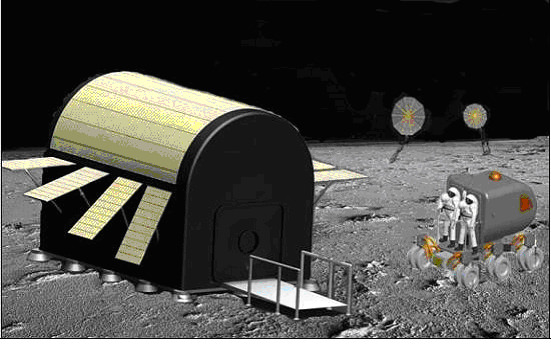[/caption]
If we’re ever going to set up bases on the Moon for long-term – or even short term — human habitation, we’ll need to overcome the problems of radiation from cosmic rays and solar flares. Another issue for lunar outposts is setting up usable power generating systems. Recently, a group of students at North Carolina State University potentially tackled both problems by developing a “blanket” that covers lunar outposts to provide protection for astronauts against radiation while also generating and storing power.
Space radiation has long been known to be a problem for lunar explorers. The Apollo astronauts had little protection, but were only on the Moon for a short time. NASA is hoping to return to the Moon by 2020 for longer sorties and eventually to build a lunar outpost.
The cosmic rays are bad enough themselves, but when they hit matter, they also produce a dangerous spray of secondary particles which, when penetrating human flesh, can damage DNA, boosting the risk of cancer and other maladies.
Michael Sieber, Ryan Boyle and Anne Tomasevich, all recent graduates of the textile engineering program at NC State came up with a design called a “lunar texshield.” The blanket-like cover is made from a lightweight polymer material that has a layer of radiation shielding that deflects or absorbs the radiation so astronauts are only exposed to a safe amount. The outermost surface of the shield includes a layer of solar cells to generate electricity, backed up by layers of radiation-absorbing materials. The advantages of the materials used in the design include flexibility, large surface area, ease of transportation, ease of construction and the ability to have multiple layers of independent functional fabrics.

The students’ design was reviewed by a panel of industry experts and chosen as one of 10 undergraduate abstract finalists in the Revolutionary Aerospace Systems Concepts Academic Linkage (RASC-AL) competition. This competition is sponsored by NASA and the National Institute of Aerospace, and challenges university students to think about what sorts of conditions astronauts will face when returning to the moon, then design projects that might become part of actual lunar exploration.
“We had many factors to consider in developing this outpost cover – not just being able to protect against radiation,” Sieber says. “The product needed to be as lightweight as possible to feasibly fit on the transportation module, and have the ability to be easily erected by a minimum number of astronauts for immediate use once landing on the moon.”
“These obstacles are where our knowledge of textile properties will give us an advantage,” added Dr. Warren Jasper, professor of textile engineering and advisor for the project. “This is a competition aimed at aerospace engineering students, but we understand the properties associated with different textile materials, and that gives us unique insight on how to troubleshoot some of these issues.”
The students will present their lunar texshield at the 2009 RASC-AL Forum held June 1-3 in Cocoa Beach, Fla. The project will be judged by a steering committee made up of experts from NASA, industry and universities.
“We aren’t even sure what the prize is for being named first place – but that wasn’t what was important to us,” Sieber says. “We used what we’ve learned throughout our college careers and were able to apply that logic to provide a solution a real-world problem. That is what is cool to us.”
Source: North Caroline State University


I’d suggest they find the momentos left on the Moon during the Apollo days and see what conditions the momentos are in-if they have many tiny holes caused by many tiny meteor strikes, then the ‘blanket had better be hardened to stop tiny meteors from entering the ‘shelter’
The question is what kind of timeframe are we looking at?
The Apollo sites are going on forty years old and will show the effects of damage for much longer than we plan a moonbase to last right now.
A moonbase of today would most likely be a modified lander. Unmanned and unweighted by return systems, it can carry the equipment needed for longer term survival than a regular Altair.
A base made to survive decades will more likely be below ground. There you only need systems like these to protect the exit areas.
Maxwell
Your explanation of a long duration base makes sense, being below ground. Nothing is more frightening then to know from time to time a meteor much smaller than a bullet but far faster at 15MilesPerSecond or 25KPS will punch a hole through the roof and through the floor. We on Earth take this for granted when we see a ‘common appearing’ meteor in the night sky burning up high in our atmosphere.